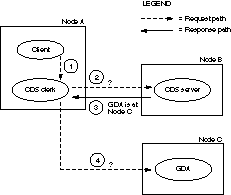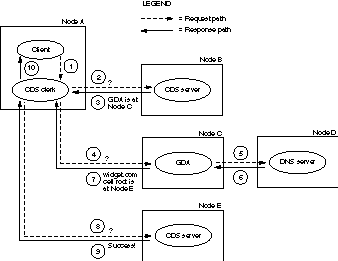Figure 7-1: How the CDS Clerk Finds a GDA

![]()
[Previous] [Next] [Contents] [Index]
7.1 Overview of Intercell Naming
NOTE:
If the cell name is an X.500 formal name, then either GDS or an LDAP
server may be used as the global name server.
7.2 How the Global Directory Agent Works
When a CDS server receives a request for a name that is not in the local cell, the server examines the CDS_GDAPointers attribute of the cell root directory to find the location of one or more GDAs. The next figure shows how a CDS clerk and CDS server interact to find a GDA.
Figure 7-1: How the CDS Clerk Finds a GDA

![]()
The following steps summarize the GDA search that is illustrated in the preceding figure:
The next figure shows how CDS and a GDA interact to find a name in a foreign cell that is defined in DNS. Suppose the name is /.../widget.com/printsrv1, which represents a print server in the foreign cell.
Figure 7-2: How the GDA Helps CDS Finds a Name

![]()
The following steps summarize the name search that is illustrated in the preceding figure:
Note also that a GDA knows its own cell name and can therefore avoid contacting a global directory service to look up names in its own cell. Furthermore, the GDA can recognize whether a cell name conforms to the X.500 or DNS naming syntax, and it uses that knowledge to route a lookup request to the appropriate global directory service. If the cell name conforms to the X.500 naming syntax, the GDA will first send the request to the LDAP client and then to the GDS client if it is not resolved by the LDAP client/server.
7.3 Managing the Global Directory Agent
The GDA runs as a process called gdad. To start the gdad process, follow these steps:
# kill pid
7.4 Enabling Other Cells to Find Your Cell
You can also define and maintain a cell entry in the CDS namespace of another cell. This type of definition exists in a hierarchical cell configuration.
7.4.1 Defining a Cell in the Domain Name System
dcecp> directory show /.../cs.tech.edu
To create a new resource record in the DNS namespace, use the information from the directory show command and place the properly formatted data into the DNS data file.
7.4.2 Defining a Cell in the Global Directory Service
To create a new resource record in GDS, use the information from the directory show command to fill in the fields of Mask 21 (CDS-Cell) and Mask 22 (CDS-Replica) in the GDS administration program.
7.4.3 Defining a Cell in an LDAP Server
The ldap_addcell command has the following syntax:
ldap_addcell -h ldap_server -a authentication_DN -p password [-o object_class,object_class...]|[-d]
The command must be run with root authority and prints a message to
stderr.
The following ldap_addcell examples assume the following:
gdatest is a user that has write access to the LDAP server.
gdatest is also the password of the user gdatest.
organizationalUnit is allowed to contain the auxiliary object, dceCellInfo.
This example shows the normal creation of the cell bindings in the LDAP server.
This example shows the deletion of the CDSCELL and CDSREPLICAS attributes.
ldap_addcell -h mymachine.mycity.mycompany.com -a
"cn=gdatest,ou=houston,o=compaq,c=us" -p "gdatest
Most parameters of the ldap_addcell command have a corresponding environment variable which is used when the corresponding parameter is not present on the ldap_addcell command invocation. Table 7-1 lists environment variables.
| ldap_addcell Parameter | Environment Variable |
|---|---|
|
-h
|
LDAP_SERVER
|
|
-a
|
LDAP_AUTH_DN
|
|
-p
|
LDAP_AUTH_DN_PW
|
|
-o
|
LDAP_OBJECT_CLASS
|
NOTE:
The -d parameter does not have a corresponding environment variable.
[Previous] [Next] [Contents] [Index]
To make comments or ask for help, contact support@entegrity.com.